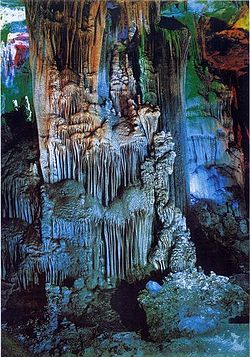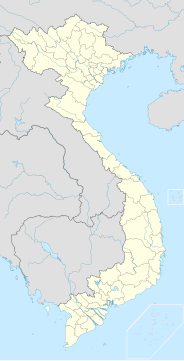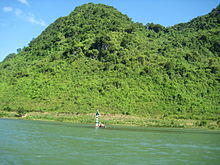Phong Nha-Kẻ Bàng
| Phong Nha-Kẻ Bàng | ||
|---|---|---|
|
|
||
| Location: | Vietnam | |
| Next city: | Dong Hoi | |
| Surface: | 857.54 km² | |
| Founding: | October 1, 1990 | |
The Phong Nha-Kẻ Bàng National Park (PNKB, Vietnamese Vườn quốc gia Phong Nha-Kẻ Bàng ) is part of the Bố Trạch and Minh Hoa districts in the Quảng Bình province of north-central Vietnam , about 500 kilometers south of the Vietnamese capital Hanoi , where the country forms a narrow bridge between the South China Sea and Laos . It extends over an area of around 86,000 hectares and is located directly on the border with Laos.
geology
The karst formation of the Phong Nha-Ke Bang National Park has developed since the Paleozoic Era (about 400 million years ago) and is the oldest significant karst region in Asia. As a result of tectonic processes, the karst landscape of the park is specifically composed and shows numerous and very remarkable geomorphological features. The wide area shows impressive features, including numerous grottoes such as the Én cave and underground rivers over 65 kilometers in length.
In April 2009, British researchers discovered twenty new caves in this national park with a total length of 56 kilometers, including what they say is the largest in the world. The Sơn Đoòng Cave is larger than the Deer Cave in Malaysia (in Gunung Mulu National Park ).
Phong Nha-Ke Bang National Park |
|
|---|---|
|
UNESCO world heritage |
|

|
|
| Tien Son cave |
|
| National territory: |
|
| Type: | nature |
| Criteria : | vii |
| Reference No .: | 951 |
| UNESCO region : | Asia and Pacific |
| History of enrollment | |
| Enrollment: | 2003 (session 27) |
| Extension: | 2015 |
UNESCO World Natural Heritage
In 2003 the national park was included in the list of the world natural heritage sites of Vietnam by UNESCO . It is located 450 kilometers southeast of Hanoi , 45 km northwest of Dong Hoi and 300 km northwest of Da Nang and forms the centerpiece of the last closed forest area in central Vietnam. The national park lies directly on the border with Laos and belongs to the Annamite mountain range , which is known for its bizarre limestone cliffs and caves as well as for its immense biodiversity.
The park area, together with the Hin Namno biodiversity reserve on the Laotian side, is one of the two largest limestone areas in the world and includes several hundred caves, including long corridors with stalactites and stalagmites . British and Vietnamese scientists have explored twenty kilometers of it. There are many underground rivers and waterfalls.
Flora and fauna
With 381 described vertebrate species, including 59 amphibian species, Phong Nha-Ke Bang is home to a great diversity of species. The park is considered a floristic center of high biodiversity in Indochina; there are more than 1320 described plant species here. 112 species of mammals alone live in the park, including at least nine species of monkeys such as macaques , langurs and gibbons .
New animal species are regularly discovered in the Annamites. These include the Saola antelope , the giant muntjac , the Annamite striped rabbit and the endangered gray-nosed monkey .
flora
The most common tree species in this park are Hopea sp., Sumbaviopsis albicans , Garcinia fragraeoides , Burretionendron hsienmu , Chukrasia tabularis , Photinia aroboreum and Dysospyros saletti . Evergreen trees dominate the park, especially Dipterocarpus kerri , Anogeissus acuminate , Pometia pinnata and Lagerstroemia calyculata .
In this park area are the dominant families: Lauraceae , Fagaceae , Theaceae and Rosaceae , and gymnosperms such as Podocarpus imbricatus , Podocarpus neriifolius and Nageia fleuryi .
At least three rare orchid species have been described, Paphiopedilum malipoense , Paphiopedilum dianthum , and Paphiopedilum concolor .
Endemic species in this national park are: Burretiodendron hsienmu , Cryptocarya lenticellata , Deutrizanthus tonkinensis , Eberhardtia tonkinensis , Heritiera macrophylla , Hopea . Sp, Illicium parviflorum , Litsea baviensis , madhuca pasquieri , Michelia faveolata , Pelthophorum tonkinensis , annamensis Semecarpus , Sindora tonkinensis .
fauna

The area is about 800 km². The project was founded in 1999 by the Cologne Zoo together with the Hanoi National University . The Cologne Zoo is committed to forest protection there and trains rangers . The recording of species diversity is the basis of species protection . Numerous species have been discovered over the past decade. Together with the Frankfurt Zoological Society ( Germany ), a sanctuary for ten primate species, including the Hatinh langur and the red-legged robed monkey, is being funded. On November 3, 2005, Germany agreed to support the national park with 12.6 million euros. This is primarily intended to preserve the biodiversity of the area.
Several mammalian species are classified as endangered, including Capricornis sumatraensis , Megamuntiacus vuquangensis and likely endangered species are: Saola ( Pseudoryx nghetinhensis ), Asiatic black bear ( Ursus thibetanus ) and Helarctos malayanus . The Malay pangolin ( Manis javanica ) and the Annamite striped rabbit ( Nesolagus timminsii ) also live in this area . Of the small mammals in the park, 18 are on Vietnam's Red List of Endangered Species and 6 are on the Red List. Ten species of bat are on the Red List of Endangered Species .
72 bird species live in the park, the most common of which are: Arborophila charltonii , Picus rabieri , Anorrhinus austeni , Stachyris herberti and Jabouilleia danjoui .
In 2005, German and Vietnamese scientists discovered a new gecko species ( Cyrtodactylus phongnhakebangensis ) endemic to the park . Another endemic Gekko, Gekko scienciadventura , received its scientific name in 2004 in honor of the ZDF TV show Adventure Knowledge . As early as 1999, an international team of researchers discovered the three-horned pit viper, which is also endemic in the national park.
72 species of fish have been described, four of which are on the Red List, including Chela quangbinhensis .
tourism
The tourism service center is located in the municipality of Son Trach, in the Quang Trach district. The park is accessible to visitors by train (Saigon-Hanoi route), bus (National Road 1A) or plane ( Dong Hoi Airport ). The park is on the Ho Chi Minh Trail . The north-south train stops in Đồng Hới . The Vietnam Airlines operates the Noi Bai International Airport ( Hanoi ). This airline was connected to Tan Son Nhat International Airport (in Ho Chi Minh City ) in 2009 . Tourists from the tourism center are available in English , French and Chinese .
The tourism sector, which is developing dynamically but not in an environmentally friendly way, is both a threat and an opportunity for the park. Currently, around 200,000 tourists a year come, mainly from inland, who visit the park's famous limestone caves from a boat. The local population has a share in this, for example through boat rentals and the hotel and catering trade. In particular, the park management and the regulatory authorities are required to provide and maintain the tourist infrastructure.
Movie
- Vietnam's mined paradise. In the Phong Nha-Ke Bang National Park. Documentary, Germany, 2009, 52:26 min., Script and direction: Therese Engels, production: MedienKontor FFP, GEO , arte , series: 360 ° - Geo Reportage , first broadcast: January 9, 2010 by arte, summary by GEO and ARD .
See also
Web links
- Forest protection in Phong Nha-Ke Bang National Park in Vietnam. In: GEO , March 8, 2012.
- Project - Phong Nha Ke Bang National Park. ( Memento from January 4, 2011 in the Internet Archive ) In: KfW Development Bank , April 2008
- Protection for animals and plants. ( Memento of August 3, 2009 in the Internet Archive ) In: BMZ , 2007.
Individual evidence
- ↑ a b Phong Nha-Ke Bang National Park . United Nations Environment Program . March 2003. Retrieved February 21, 2008.
- ↑ a b Phong Nha-Ke Bang National Park. In: UNESCO , accessed October 29, 2015.
- ↑ NN : British explorers discover the light at the end of the tunnel ... in the world's largest cave. In: Daily Mail , May 5, 2009.
- ↑ a b Forest protection in the Phong Nha-Ke Bang National Park, Vietnam. ( Memento of November 14, 2011 in the Internet Archive ) In: GEO , June 7, 2011.
- ↑ a b Ralf Hendrix, Stéphane Grosjean, Le Khac Quyet, Miguel Vences, Vu Ngoc Thanh & Thomas Ziegler: Molecular identification and description of the tadpole of the Annam Flying Frog. In: mvences.de (Miguel Vences), accessed on October 29, 2015 (English, PDF; 10 p., 279 kB).
- ^ Nils-Henning Meyer: Vietnam: World Natural Heritage in waiting. ( Memento of the original from March 5, 2016 in the Internet Archive ) Info: The archive link was inserted automatically and has not yet been checked. Please check the original and archive link according to the instructions and then remove this notice. In: KfW Development Bank
- ↑ a b Vườn quốc gia Phong Nha - Kẻ Bàng. ( Memento of March 28, 2008 in the Internet Archive ) In: Communist Party of Vietnam , November 1, 2005.
- ^ Phong Nha-Ke Bang National Park, Vietnam. In: The Encyclopedia Earth , August 22, 2008, (English).
- ↑ Những phát hiện mới tại Phong Nha - Kẻ Bàng. ( Memento from June 21, 2007 in the Internet Archive ) In: thiennhien.net , June 16, 2007.
- ↑ Những phát hiện chấn động về Phong Nha - Kẻ Bàng . In: Thanh Niên . September 6, 2005. Archived from the original on September 13, 2006. Retrieved on February 5, 2008.
- ↑ a b The World Heritage Phong Nha - Kẻ Bàng National Park, Quảng Bình Province, Việt Nam . Vietnam Geological and Mineral Resources Department. July 23, 2006. Retrieved February 26, 2008.
- ↑ Thomas Ziegler: Biological Diversity. Preserve amphibian diversity. ( Memento of the original from December 2, 2008 in the Internet Archive ) Info: The archive link was automatically inserted and not yet checked. Please check the original and archive link according to the instructions and then remove this notice. In: bundesregierung.de
- ↑ Đức giúp Vườn quốc gia Phong Nha - Kẻ Bàng. ( Memento from August 16, 2007 in the Internet Archive ) In: German Embassy Hanoi , November 3, 2005.
- ↑ Phong Nha - Ke Bang National Park. ( Memento of October 4, 2008 in the Internet Archive ) In: Bird Life Indochina, Birding Center in Vietnam , 2007.
- ^ New Lizard Species Found In Phong Nha-Ke Bang. ( Memento from October 14, 2013 in the Internet Archive ) In: SwellReptiles , September 2007, (English).
- ↑ Phong Nha-Ke Bang. Conservation in Vietnam. ( Memento from December 19, 2008 in the Internet Archive ) In: Kölner Zoo , 2005.
- ↑ Thomas Ziegler: Research into biodiversity in the Vietnam project of the Cologne Zoo: The amphibians and reptiles of Phong Nha-Ke Bang. In: Zeitschrift des Kölner Zoo , No. 4, 2004, pp. 147–171, (PDF; 25 pp., 2,350 kB).
- ↑ Route network. In: Vietnam Airlines , (German), accessed October 29, 2015.
- ↑ Quang Binh province urged to fully tap its advantages. ( Memento of April 30, 2009 in the Internet Archive ) In: VietnamNet , April 26, 2009.







